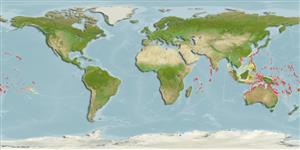Common names from other countries
>
Acanthuriformes (Surgeonfishes) >
Acanthuridae (Surgeonfishes, tangs, unicornfishes) > Acanthurinae
Etymology: Acanthurus: Greek, akantha = thorn + Greek, oura = tail (Ref. 45335).
More on author: Forster.
Environment: milieu / climate zone / depth range / distribution range
Ecologia
marinhas associadas(os) a recifes; intervalo de profundidade 0 - 10 m (Ref. 128797). Tropical; 30°N - 30°S, 52°E - 140°W
Indo-Pacific: oceanic islands in the western Indian Ocean to the Hawaiian, Marquesan and Tuamoto islands, north to the Ryukyu Islands, south to New Caledonia and Rapa.
Tamanho / Peso / Idade
Maturity: Lm ? range ? - ? cm
Max length : 26.0 cm TL macho/indeterminado; (Ref. 9710)
Espinhos dorsais (total) : 9; Raios dorsais (total) : 27 - 30; Espinhos anais: 3; Raios anais : 23 - 26. Preserved color is brown; spotted, white spots usually bordered with dark brown (may help conceal it in turbulent water that is often filled with small bubbles). Pelvic fins bright yellow. Each side of caudal peduncle with a single, sharp, forward-pointing erectile spine. Gill rakers on anterior row: 21-24; gill rakers on posterior row: 19-23.
Occurs in surge zone of clear seaward reefs (Ref. 9710, 58302). Benthopelagic (Ref. 58302); mainly oceanic and found schooling in shallow depths over reef flats subject to surge or currents (Ref. 48637). Browses on filamentous and calcareous algae. Forms schools.
Ciclo de vida ou comportamento de acasalamento
Maturities | Reprodução | Spawnings | Egg(s) | Fecundities | Larvas
Randall, J.E., 1956. A revision of the surgeonfish genus Acanthurus. Pac. Sci. 10(2):159-235. (Ref. 1920)
Status na Lista Vermelha da UICN (Ref. 130435)
CITES (Ref. 128078)
Not Evaluated
Ameaça para os humanos
Harmless
Uso pelos humanos
Pescarias: espécies comerciais; Aquário: Espécies comerciais
Ferramentas
Relatórios especiais
Baixar XML
Fontes da internet
Estimates based on models
Preferred temperature (Ref.
115969): 25 - 29.3, mean 28.2 (based on 1389 cells).
Índice de diversidade filogenética (Ref.
82804): PD
50 = 0.5000 [Uniqueness, from 0.5 = low to 2.0 = high].
Bayesian length-weight: a=0.02884 (0.01655 - 0.05024), b=2.97 (2.82 - 3.12), in cm Total Length, based on LWR estimates for this species & Genus-body shape (Ref.
93245).
Nível Trófico (Ref.
69278): 2.0 ±0.00 se; based on food items.
Resiliência (Ref.
120179): Elevada, tempo mínimo de duplicação da população menor que 15 meses (Preliminary K or Fecundity.).
Fishing Vulnerability (Ref.
59153): Low vulnerability (16 of 100).
